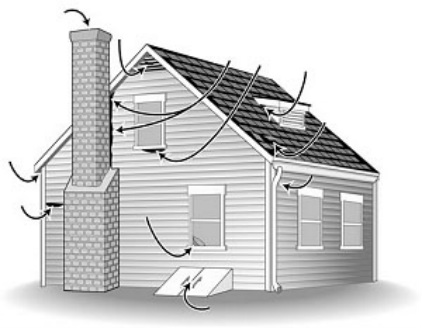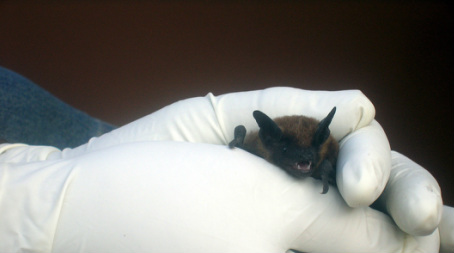|
Questions about Bats
How Do I Know if I Have Bats? Bats can sometimes be detected by the presence of black or brown stains from body oils or droppings around cracks or crevices formed by ill-fitting building materials. Bat droppings may also appear on walls, under porches or decks, or on floors beneath dilapidated ceilings. Bat droppings are dark and do not contain any white material. Although they may resemble small hard rodent pellets, bat droppings are soft and easily crushed, revealing shiny insect parts. Where do bats roost? Bats may roost in attics, soffits, louvers, chimneys, under siding, eaves, roof tiles or shingles and behind shutters (see diagram). In sports stadiums and parking garages, bats sometimes roost in expansion joints between concrete beams. They can enter through openings as small as one-half inch in diameter (1.3 cm). Common points of entry include open windows or doors, broken or poorly-fitted screens, loose or missing shingles or tiles, places where flashing or boards have come loose and locations where pipes or wiring enter buildings. Openings often occur where walls meet the eaves at the gable ends of an attic, where porches attach to the main part of a house, or where dormers meet the roof. Other points of entry are associated with siding. For example, cracks and
crevices are often created where siding forms corners, or at places where it meets windows, doors or chimneys (see diagram). |
What if I find a bat in my home? On occasion, a solitary bat may accidently fly into a home, garage or other building through an open door or window. Such incidents often involve lost youngsters whose primary goal is a safe escape. As long as no direct contact with the bat has occurred, it can be released outside. These bats will usually leave on their own if a window or door to the outside is opened while others leading to the rest of the building are closed. Bats are rarely aggressive, even if chased, but may bite if handled. As with any wild animal, bats should not be touched with bare hands, and anyone bitten should immediately seek medical consultation. If a bat does not leave your home on its own, its exit can be hastened by waiting until it lands, and then covering it with a small box or other container. Slip a piece of cardboard between the wall and box, slide the bat into the box, then release the bat outside. You may also catch it by hand, using leather work gloves to avoid being bitten. Keep doors and windows to buildings closed, and window screens in good repair, to prevent bats from reentering. Bats often roost in buildings seasonally, including during maternity periods, and exclusions should not take place until young bats are able to fly. After the young are old enough to fly, all bats can be excluded. The maternity season begins as early as mid-April in the southernmost U.S., mid-June in the northern U.S. and Canada. Young bats are flying and exclusions can resume by late August. In late fall most house-dwellings bats either migrate to warmer climates or enter caves or abandoned mines to hibernate. However, a few species can hibernate in buildings, and in the mildest climates, they may even remain active year-round. If bats are present in cold regions during the winter, exclusions should be postponed until spring when they emerge to feed. |

